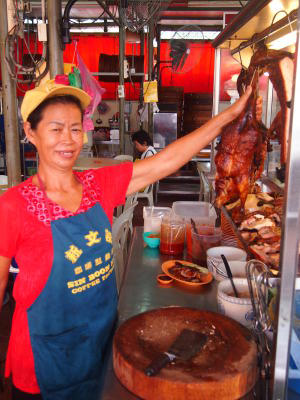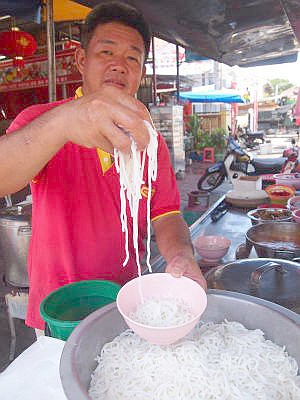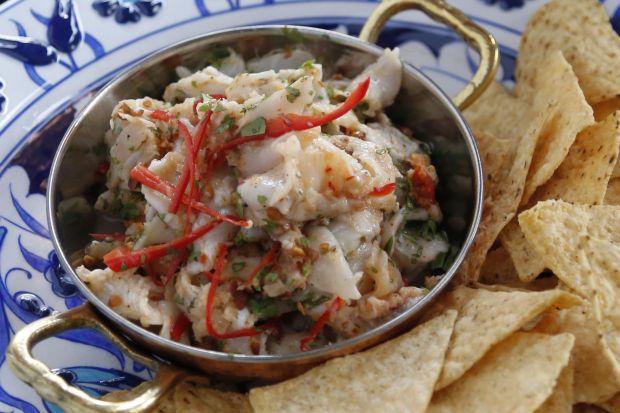Lorong Selamat has some of the best food stalls around.
ONE of the most famous streets for day-time food in Penang must be Lorong Selamat in George Town, where no fewer than 10 eateries line both sides of the short, one-way road that links Burmah Road to Macalister Road.
At the Macalister Road end, there is a concentration of stalls which purvey the best – and sometimes, if truth be told, the not-so-good – of Penang’s famous traditional street foods.
 Irresistible: Ah Eng is famous for her duck rice. The birds with tender meat are roasted at home by her husband. — Photos byHELEN ONG
Irresistible: Ah Eng is famous for her duck rice. The birds with tender meat are roasted at home by her husband. — Photos byHELEN ONGCertainly, things are dearer there. If you are not so lucky as to find street parking and have to resort to one of the few private car parks, it costs RM3 for two hours. It also has some of our more expensive stalls, averaging RM4 to RM5 for a serving as opposed to RM2 to RM3 elsewhere. Some cost even more.
At the Keng Huat Café, there’s of course the rather famous – or perhaps the more apt word is infamous – red-bereted woman who has probably gained the dubious honour of being the most famous hawker on the island, although this is as much for what some consider to be one of the best char kuey teow on the island (complete with large prawns to justify the RM8 charged per plate) as for her unique form of customer service.
Say no more.
A bit further along, Ah Guan offers some competition at the Low Eng Hoo Café. The char kuey teow is probably as good, fragrant and tasty, with crunchy pork scratchings, which, in these days of healthier living, is quite rare. His isn’t cheap either, coming in just slightly lower at RM7.50 per plate.
Opposite, there’s the T&T Hokkien Mee shop, one that is wholly dedicated to serving not just the traditional prawn-and-paikut (spare rib) soup noodles, but also several new spin-offs that they have come up with, like their claypot version.
Another is the Mid Town Café, now run by Ang Soon Lee and recently renamed the Selamat Café. This eatery starts as early as 4.30am, when Hong Kong-style dim sum is served by staff who wander about with large bamboo baskets laden with typical offerings like hargao, siew mai, fish balls, cheong fun and other fried or steamed dim sum dishes.
A few hours later, the other stallholders arrive. There’s Pan Mee, Kah Kah’s Oyster Omelette and also Sam’s Char Kuey Teow, although not as famous and therefore, at RM5 per plate, not as expensive as the aforementioned stalls.
From about noon to 5pm, Ah Eng starts selling her (justifiably) famous duck rice, which her husband roasts every day, together with the chicken and char siew. Although they’ve only just moved there from the New World Park Café, she has been cooking and selling this since 1983.
“We learnt how to do it properly from a friend who was a Hong Kong chef,” she said. They use a local variety of the Pak Kniah Ark, the white-feathered/yellow-beaked duck which apparently roasts well as the meat is more tender.
“It’s more expensive,” she added, “but it is softer.”
Ah Eng has a soft heart too: any innards and leftovers are packed up and sent to various other parts of town where they are fed to stray dogs and cats. She also raises money to help neuter them.
Parked at the very front, there’s Ah Keat’s famous laksa stall, which has been there for the last four decades.
“My father started this stall in 1969,” he explained, “after which my mother took over.”
Ah Keat now runs the place with help from his brother. They sell two versions: there’s the traditional assam (sour) variety, made with fresh sardines topped with some canned sardines, and a lemak Thai variety.
Rather unusually for laksa because of its assam (acidity), he starts selling from about mid-morning and I would suggest you go later on in the afternoon for various reasons: it’s less crowded then, so there’s more chance of finding a parking space, and, more importantly, the fish stock will have had time to simmer away, ensuring that it is more concentrated and tasty.
In fact, he’s become such an institution that keen customers will pull up next to his stall and order large quantities to take away.
 Ah Keat is famous for his two varieties of laksa. It is so good, out of-towners have been known to pack a couple of hundred bags to bring home.
Ah Keat is famous for his two varieties of laksa. It is so good, out of-towners have been known to pack a couple of hundred bags to bring home.“As soon as they tell me that it’s for taking out of town, I know what to do.”
Some have even been known to order a couple of hundred packs, although there’s no need for that now as he’s gone national – large cauldrons of both are apparently sent to KL by lorry every day.
Wrap up the meal with a bowl of their ais kacang or home-made chendol.





